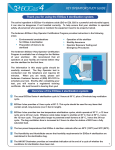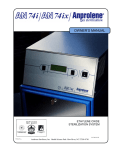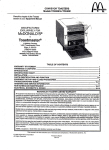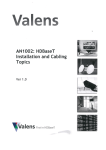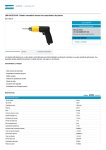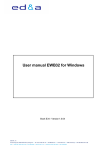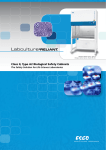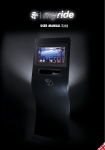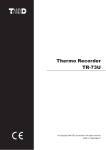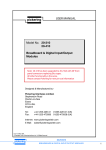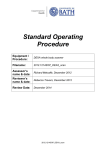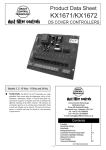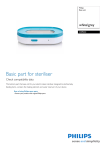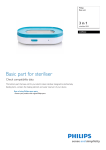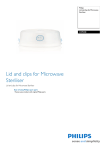Download EOGas Series-4 Key Operator Study Guide
Transcript
KEY OPERATOR TRAINING SERIES ANDERSEN PRODUCTS, LTD Study guide 4 Key Operator Training Kit The power of knowledge the future of gas sterilisation 4 Thank you for using the EOGas sterilisation system. APPLIES TO MODEL: AN4000 The active ingredient in the EOGas 4 system is ethylene oxide (EtO). EtO is a powerful anti-microbial agent; it can also be dangerous if not handled correctly. To help ensure that your steriliser is operated safely, all personnel who operate or maintain the equipment should be properly trained. The Andersen EOGas 4 Key Operator Certification Program is available free of charge for the life time of your steriliser. We recommend that all operators at your facility are trained before they use the steriliser for the first time. Certification Program Outline • • • • • • Preparing for Sterilisation ..............................................Pg 3 The Sterilisation Setup...................................................Pg 5 The Sterilisation Cycle ...................................................Pg 6 Unloading the Steriliser and Determining Sterility .........Pg 9 Safety Precautions ........................................................Pg 10 Study Guide Review ......................................................Pg 12 The information in this study guide should be carefully reviewed. The Key Operator test is conducted over the telephone and requires 20 minutes. When you are ready, please call Andersen Customer Service at 01255 428328 to schedule your Key Operator test. Shortly after successfully completing your test, you will receive a registered training certificate. We look forward to hearing from you! Overview of the EOGas 4 ® Sterilisation System. 1 1 The EOGas 4 steriliser offers a total of four different sterilisation cycles using 50ºC (122ºF) and 30ºC (86ºF) preset temperatures. EtO gas requires more time to properly sterilise when operating at lower temperatures and more time for the gas to penetrate small lumens. 2 The standard cycle is 3 hours at 50°C, plus a 30-minute bag ventilation (purge) cycle. A second cycle at 50°C runs for 5 hours and should be used for any items that contain small, long lumens over 3 feet in length. 3 EOGas 4 also provides two low, room temperature sterilisation cycles at 30°C, a 12 hour cycle and a 24 hour cycle. These low temperature cycles are best for sensitive items, and the bag ventilation time is increased to 2 hours. 4 Maintaining a relative humidity above 35% is critical to the success of the EOGas 4 cycle. The AN1071 Humidichip® and AN1072 Humiditube ensure that humidity requirements for EOGas 4 sterilisation are maintained in the sterilisation bag. 5 The AN1087 Dosimeter® provides an immediate indication at the end of a cycle that adequate time, temperature, and EtO concentration for sterilisation have been met. D E EOGas 4 Supplies & Parts Index B C F G A H A: B: C: D: E: F: G: H: I: J: Operations Display Keypad Buttons Door Lock Cooling Fan Guard with Removable Filter Power Cord Socket and Switch (on rear) Emergency Exhaust Port Sturdy Powder Coated Steel Cabinet Wrapped Sterilisation Load Purge Probe EOGas 4 Cartridge I M EOGas 4 Sterilisation Cabinet K: Gas Sterilisation Bag L: Humidichip and Tube M: Black Velcro Strap with Buckle N: Quick Release Connector J H K I L N Loaded Sterilisation Bag EOGas 4 Sterilisation Accessories AN1004 Gas Refill Kits contain replacement gas cartridges, liner bags, Dosimeter ®s, and Humidichip®s in a convenient storage/dispenser box. AN85 Exposure Indicator Strips change color to provide immediate assurance of EOGas exposure at the end of the sterilisation cycle. They include convenient self-stick backing that adheres to conventional paper or cloth wrapping. AN2203 EZ Test Biological Indicators reliably verify that sufficient concentration of EtO killed one million B. atrophaeus spores, the spore most resistant to EtO gas. Biological indicators are the best method to ensure sterility after a cycle. AN1071 Humidichip & AN1072 Humiditube These pre-moistened chips placed inside the tube ensure that relative humidity requirements are met during the sterilisation cycle. AN1087 Dosimeter Chemical Integrators present visual assurance that proper time, temperature, and EOGas concentration were reached during the sterilisation cycle. , AN91,92,& 93 AirScan EtO Monitoring Badges are single use badges that measure personnel exposure to airborne concentrations of EOGas. Immediate results are provided with no extra instruments or analysis needed. ® and Humidichip® are trademarks of Andersen Products, Ltd. 2 KEY OPERATOR STUDY GUIDE 1 Preparing for Sterilisation A. Environmental Considerations 1 35ºC 20ºC Temperature - Gas Storage Temperature: Store your EOgas refill kits in a cool, secure area. We recommend storage below 30°C. - Operational Temperature: The steriliser must be used in an area where the temperature is not less than 20°C or more than 35°C. EtO FACTS: At sea level, ethylene oxide is a liquid below 11°C. Above 11°C, EtO begins to boil and converts into a gas. EtO does not become an effective sterilant until it is 20°C. Even though the EOGas 4 cabinet is heated, make sure that the room where your EOGas steriliser is installed remains above 20°C. 2 35% Humidity Humidity is very important to the EOGas process. Relative Humidity (RH) must be at least 35% in the room where item preparation and sterilisation take place. Spores that might be on the instruments may become desiccated and more resistant to EOGas if the RH is below 35%. The simplest way to humidify items prior to sterilisation is to wash them. Items that cannot be washed (such as laptops, cameras, and delicate electronics) should be pre-humidified. Process for Pre-Humidification Using an EOGas 4 Sterilisation Liner Bag: - Make sure the steriliser is switched on so that it heats to 50° C (122° F). - Prepare the items in the load for sterilisation. Bobbin - Place the prepared items along with a Humidichip inside a sterilisation liner bag. Using the Velcro strap, securely close the neck of the bag aroung the purge bobbin. It is not necessary to attach the purge probe to the purge tube at this time. - Place the bag in the steriliser for 2 hours, then remove the bag from the steriliser for an additional 2 hours to allow for cooling. DO NOT ACTIVATE THE CARTRIDGE AT ELEVATED TEMPERATURE. - After the 2 hours of cooling, the bag may be placed in the steriliser and the cycle started normally. 3 KEY OPERATOR STUDY GUIDE B. Four Basic Steps of Pre-cleaning Follow manufacturer's instructions for cleaning and preparing reusable devices for EOGas sterilisation whenever possible. In the absence of manufacturer's instructions, these general steps should be followed: 1 Disassemble Items containing removable parts such as syringes must be taken apart before washing, drying, and wrapping them to allow the EtO an unobstructed path around all parts. WARNING: Instruments which contain batteries must be taken apart and the batteries removed and wrapped separately to protect against a spark occurring and igniting the ethylene oxide gas. 2 Wash Presoak the items, if appropriate. Items must be washed surgically clean prior to sterilisation using detergent and water. 3 Dry Three accepted ways to dry any item prior to sterilisation with EOGas 4 are: 1. Towel drying 2. Drain drying (air drying) 3. Compressed air for tubing and long lumens WARNING: Heat or hot air should not be used to dry an item prior to sterilising it with EOGas because it may dehydrate or desiccate bacteria spores making them more resistant to the ethylene oxide gas. WARNING: Any water left on items may react with ethylene oxide. Items must be thoroughly dried. AN86 4 Wrap The following types of wrapping material are recommended for use with EOGas 4: 1. Heat sealed packaging such as Tyvek® / Plastic. 2. Self seal pouches made of paper and film. 3. Cloth, paper, or Central Supply Room (CSR) wrap. Always follow manufacturer's use and shelf-life guidelines for all packaging. HINT: Exposure indicators such as the Andersen AN85 or AN86 are used to seal or label items. Indicators will change color in the presence of EOGas, helping to later identify items that have been sterilised. Exposure indicators DO NOT indicate sterility. 4 KEY OPERATOR STUDY GUIDE 2 The Sterilisation Setup A. Selecting the Cycle Length Choose the appropriate cycle for the load to be sterilised. The EOGas 4 steriliser offers four different sterilisation cycles: 50º C - 3 Hour sterilisation exposure, 30 minute bag ventilation 50º C - 5 Hour sterilisation exposure, 60 minute bag ventilation 30º C - 12 Hour sterilisation exposure, 120 minute bag ventilation 30º C - 24 Hour sterilisation exposure, 120 minute bag ventilation. ACTIVATE CARTRIDGE CLOSE DOOR SELECT CYCLE LENGTH 5 HOUR 3 HOUR For most items, the 3 HOUR cycle will be adequate. The 5 HOUR cycle should be used when sterilising lengths of tubing greater than 3 feet and with loads containing large amounts of gas absorbing materials. For temperature sensitive items, use the 12 or 24 HOUR room temperature (30º C) mode. B. Warming Up the Steriliser EOGAS 4 STERILIZER START 1 SELF TEST OK 0 PUMP HOURS Make sure the EOGas 4 is connected to power, and turn the steriliser on by pressing the black power switch located on the back of the cabinet. The initial startup screen will appear. EOGAS 4 STERILISER SETUP 22.0ºC START ROOM TEMPERATURE STERILISATION MODE SETUP 22.0ºC START 2 The temperature setting can be switched between standard (50ºC) and room temperature (30ºC) modes using the setup menu. Once set, press the button to the right of START on the display screen to initiate the self test. 3 When the warm up screen appears, you can exit or await the target temperature reading. EXIT 4 EOGAS 4 WARMUP 31.0ºC Once warmed up, loading instructions are shown on the screen. LOAD EOGAS LINER BAG CLOSE BAG OVER TUBE PURGE BAG EXIT 48.0ºC PURGE 5 KEY OPERATOR STUDY GUIDE 3 The Sterilisation Cycle A. Loading the Liner Bag and Steriliser 1 WARNING: Use only genuine EOGas 4 products in your steriliser. Use of other gas sources may result in operator injury and/or non-sterile loads. WARNING: Do not reuse sterilisation liner bags. Even a tiny pinhole in a liner bag can allow gas to escape and cause cycle failure! 2 3 4 QUICK CONNECT BOBBIN Place prepared items into a new sterilisation liner bag. WARNING: Liquids, powders, food, and drugs should not be sterilised in ethylene oxide because it may change their chemical composition in unpredictable ways. If you have any questions about whether an item may be sterilised using EOGas, please call Andersen Customer Service 01255 428328. 2 Insert appropriate controls such as a chemical integrator (Dosimeter) or a biological indicator (EZ Test) into the least accessible part of the sterilisation liner bag. Add a Humidichip to the Humiditube and place into the sterilisation liner bag. 3 Remove one AN1004 EOGas cartridge from the Refill Kit. Remove the tape and safety trigger guard on the cartridge and place the cartridge on top of the wrapped items so it can easily be manipulated through the wall of the bag. Do not activate the cartridge at this time. 4 Insert the purge probe into the sterilisation liner bag with the bobbin and quick release fitting at the open end. Place the black Velcro® strap around the sterilisation liner bag and the bobbin of the purge probe, and pull it snug through its loop to completely close the sterilisation liner bag. The strap must tightly secure the sterilisation liner bag around the purge probe bobbin in order to keep gas from escaping. 5 Connect the quick release connector to the purge probe hose if it is not already connected. Bobbin 5 HINT: The sterilisation liner bag may be loaded and sealed away from the steriliser cabinet and connected to the purge tube once the steriliser has warmed up. 6 KEY OPERATOR STUDY GUIDE B. Starting the Cycle With the loaded bag sealed and connected to the purge tube, press the PURGE button. LOAD EOGAS LINER BAG CLOSE BAG OVER TUBE PURGE BAG EXIT 48.0º C PURGE INITIAL PURGE 00:01:29 REMAINING EXIT 50.0ºC The steriliser will purge air out of the sterilisation liner bag for 1 minute 30 seconds until the display reads '00:00:00'. The sterilisation liner bag should vacuum down as excess air is removed. After the initial purge has been completed the display instructs the operator to activate the cartridge, close the door, and select the cycle length: ACTIVATE CARTRIDGE CLOSE DOOR SELECT CYCLE LENGTH 5 HOUR 3 HOUR 1 or ACTIVATE CARTRIDGE CLOSE DOOR SELECT CYCLE LENGTH 24 HOUR 12 HOUR Activate the cartridge by pressing the trigger button on the cartridge through the wall of the closed liner bag. Make sure that the button is fully depressed. Note: The EOGas 4 cartridge has the precise amount of EtO needed to sterilise contents of the EOGas 4 sterilisation bag. 2 Close the door. 3 Select the length of the sterilisation cycle. (3 or 5 hours when in 30ºC mode) or (12 or 24 hours when in 50ºC mode). The door will lock automatically. ACTIVATE CARTRIDGE If a cycle time is not selected within 5 seconds after closing the door, a continuous alarm will sound to remind you to choose a cycle length. CLOSE DOOR SELECT CYCLE LENGTH 5 HOUR 3 HOUR 3 HOUR CYCLE STERILISING 2:59:15 REMAINING 30.0ºC 4 7 or 12 HOUR CYCLE STERILISING 11:59:15 REMAINING 50.0ºC After the cycle length is selected, the display counts down time remaining. The door will remain locked. KEY OPERATOR STUDY GUIDE WARNING: Never interrupt a cycle once the gas cartridge has been activated. 5 Log sterilisation data if required. C. Additional Aeration Throughout the entire cycle, the ventilation system is always running to prevent EtO gas from entering the room. At the end of the sterilisation cycle, the cabinet ventilation pump and the purge pump will run in 2 minute intervals, purging the liner bag and ventilating the cabinet. This purge cycle continues for 30 minutes for the 3 hour cycle, 1 hour for the 5 hour cycle, and 2 hours for the 12 or 24 hour cycle. VENTILATING BAG 00:23:55 REMAINING 50.0ºC Once the purge cycle is complete, the steriliser will continue to ventilate and purge the liner bag. A count-up timer will begin on the steriliser display to keep track of this additional aeration time, and the steriliser will reset only after the door is opened and the exit button is pressed. The temperature in the room should continue to remain at least 20°C during the aeration period. Some gas absorbent items require additional aeration after the regular sterilisation/purge cycle and before they can be removed and used. This extra aeration prevents chemical burns to living tissue that can be caused by residual EtO absorbed during the sterilisation cycle. AAMI guidelines state that product aeration should take place inside the steriliser cabinet. D. Aeration Guidelines Some large, gas absorbing items (especially implants, long lengths of tubing, and devices that will contact blood or living tissue) require additional aeration time: 1 If the item's manufacturer provides guidelines on aeration required after EtO sterilisation, always follow those guidelines. 2 Two types of materials that do not require additional aeration are metal and glass. Items made of these materials do not absorb EtO. 3 If the item's manufacturer does not provide guidelines on aeration required after EtO sterilisation, the item should remain in the EOGas steriliser to aerate for an additional 24 hours after the sterilisation and purge cycles are complete. 8 KEY OPERATOR STUDY GUIDE 4 Unloading The Steriliser And Determining Sterility A. Unloading the Liner Bag 1 Remove the sterilised items only after the sterilisation cycle, purge cycle, and any additional aeration have been completed and the display indicates UNLOAD STERILISER. UNLOAD STERILISER 00:03:11 EXIT 50.0ºC HINT: To unload the sterilisation liner bag away from the steriliser, simply detach the purge probe hose from the bag using the quick release connector. 2 Remove the sterilised items and examine the Dosimeter. Make sure the blue line has progressed up to or beyond the triangular mark. 3 Discard the sterilisation bag, Humidichip, and used cartridge with ordinary trash. Incubate Biological Indicator if using one. Retain Humiditube to use again. 4 Press EXIT to end the cycle and return the steriliser to the standby state. Switch the power button to off. WARNING: Never remove items before the full sterilisation and purge cycles have completed. The purge cycle is designed to aerate most products sufficiently to avoid operator exposure to EOGas and to meet the OSHA short-term exposure level (STEL) of 5.0 ppm over 15 mins. B. Important Notes About Indicators 1 Biological Indicators (BI's) such as the AN 2203 EZ Test use live spores and are the best confirmation of the success or failure of a sterilisation cycle. Always follow manufacturer's recommendations when using BIs. 2 Chemical Exposure INTEGRATORS such as the AN87 Dosimeter provide immediate visual confirmation that time, temperature, and EOGas concentration were sufficient for sterilisation to occur. 3 Chemical Exposure INDICATORS such as the AN85 or AN86, do not prove sterilisation. They only change color to show that the items have been exposed to ethylene oxide. Please refer to manufacturer's instructions when using sterility or exposure indicators. 9 KEY OPERATOR STUDY GUIDE 5 Safety Precautions A. Ethylene Oxide Safety B MONITORING SYSTEM 1 Do not allow open flame or sparks near the steriliser during the sterilisation cycle. Ethylene oxide gas is highly flammable in concentrations above 3.0% (30,000 ppm). 2 Never interrupt a cycle in progress. Two consequences of removing and opening the EOGas bag before the cycle is complete are: - The load might not be sterile - The bag may still contain high levels of EOGas and put the operator at risk of unsafe exposure 3 Sterilisation liner bags should never be reused because they may have a puncture or tear. 4 Each of the sterilisation cycles ends with a purge cycle that flushes fresh air around the items in the load. 5 Personnel exposure to ethylene oxide can be monitored by using personal exposure badges such as the Andersen AN93 AirScan® Badges. The AN93 AirScan Kit has both STEL (15 min.) and TWA (8 hour) badges. EtO exposure levels should be checked upon installation of the steriliser. We recommend that exposure testing be performed on an annual basis or whenever a steriliser is relocated. OSHA guidelines for personal monitoring can be found at www.cdc.gov/niosh/programs/ppt. 6 If a cartridge is accidentally activated outside of the liner bag, immediately place it in the Zip-Lock Safety Bag and connect the quick connect fitting to the input on the upper left side of the steriliser. Ensure the steriliser's ventilation pump is running. See section 1 of the User's Manual for more detail about this procedure. 7 Always store gas cartridges and refill kits in a secure area that is kept cool (30ºC or below) and out of direct sunlight. A Note: No other container or steriliser may be used with EOGas sterilising gas. B. Malfunctions and Power Failures In the event of a PURGE PUMP FAILURE error message during the sterilisation cycle, the bag must be manually tended to by a supervisor. The items in the load should not be considered sterile. 10 KEY OPERATOR STUDY GUIDE If a PURGE PUMP FAILURE occurs during the purge cycle, the vent pump will run and items should be aerated for two hours in the steriliser cabinet with the black Velcro strap removed. The items in the load may still be considered sterile. In the event of a VENT PUMP FAILURE error message during the sterilisation cycle, the purge pump will remove any remaining gas, and the cycle will be aborted. Items in the load should not be considered sterile. If a VENT PUMP FAILURE occurs during the purge cycle, the purge pump will remove any remaining gas and an error message will display at the end of the cycle. The items in the load may still be considered sterile. If a POWER OUTAGE occurs, the steriliser is equipped with a battery backup that will keep track of elapsed cycle time. If the outage occurs during the sterilisation cycle, the temperature of the cabinet may drop too low and the steriliser will display whether or not the cycle has failed. If it has, the items in the load may not be considered sterile. If the POWER OUTAGE occurs during the purge cycle, the steriliser will resume aeration when power returns. Items may still be considered sterile. Do not open the door of the steriliser until power is restored and the vent/purge systems have removed any residual gas from the liner bag. Call Andersen Customer Service for assistance with any malfunctions, 01255 428328. See section 6 of the User's Guide for more details about proper troubleshooting procedures. HINT: In the case of any steriliser malfunction or power failure, you can determine whether sterilisation was achieved by examining the indicators included in the load (such as chemical integrators and biological indicators). C. Emergency Procedures 11 1 If liquid EOGas comes into contact with a part of the body you must wash with water thoroughly for at least 15 minutes. Consult the Material Safety Data Sheet (MSDS) for further information. 2 The Material Safety Data Sheet (MSDS) for EOGas should be readily available. Do you know where to find your MSDS? - Operator's Manual - List of physical and chemical hazards is provided with each EOGas refill kit. KEY OPERATOR STUDY GUIDE In case of emergency, please contact: Chem-Tel on 001 813 248 0585 Chem-Tel contract number MIS 0000425 5 Study Guide Review Here is what you should know after reading this study guide: • • • • • • • • • The minimum temperature needed in the room for the entire sterilisation cycle The length (in time) of the standard cycle Why the ventilation system is running during the entire cycle Why the sterilisation liner bag is purged The required relative humidity in the room where the items are prepared How to prepare items for sterilisation The types of indicators that should be used in the EOGas system Ethylene oxide safety and precautions Basic operation of your EOGas steriliser from start to finish When you feel comfortable with answers to these subjects, please give Andersen Products a call at 01255 428328 and schedule your Key Operator Certification exam. The test will take approximately 20 minutes. Operator training records should be maintained at your facility. Key Operator Tests will also be kept on file at Andersen Products. If you would like to have an Andersen representative come to your facility for on site training, please contact Andersen Products for a quote on this custom service. Many thanks for using the Andersen EOGas 4 steriliser. Please do not hesitate to call us if you have any questions in the future. Andersen Customer Service 01255 428328 www.anderseneurope.com Nothing in this guide should be taken to amend or supercede the manufacturer’s reprocessing instructions. 11 12 KEY OPERATOR STUDY GUIDE Other Resources Andersen Website: www.anderseneurope.com 13 1 MSDS on Ethylene Oxide reference may be found at http://www.anderseneurope.com/english/images/library/safety/materialsafetydata.pdf 2 OSHA Small Business guide to Ethylene Oxide may be found at http://www.osha.gov/Publications/ethylene-oxide-final.html KEY OPERATOR STUDY GUIDE Questions & Notations Please use this area to list any questions that you have for your Andersen Representative regarding your EOGas 4 Steriliser. 14 the future of gas sterilisation www.anderseneurope.com Andersen Products Ltd. Davy Road, Gorse Lane Ind. Est. Clacton-On-Sea CO15 4XA, UK © 2013 ANDERSEN PRODUCTS, LTD. ALL RIGHTS RESERVED. AirScan® is a trademark of AirScan Environmental Technologies, Inc. , ®, Humidichip®, Seal and Peel® are trademarks of Andersen Products, Ltd. Ref: EOGas 4 Study Guide 201302
















